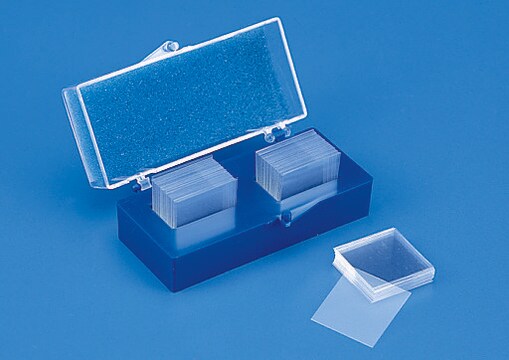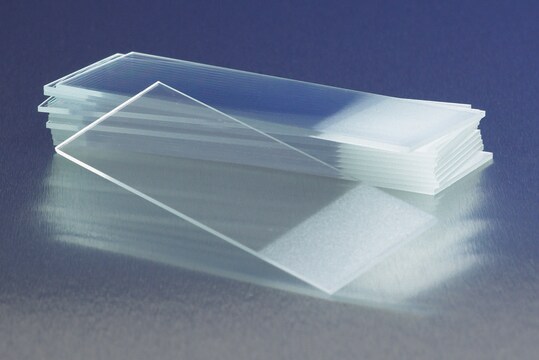S7117
ApopTag Plastic Coverslip
APOPTAG Plastic Coverslips are designed to be custom fitted to the specific APOPTAG kit application.
Sinónimos:
Plastic coverslip
Iniciar sesiónpara Ver la Fijación de precios por contrato y de la organización
About This Item
Código UNSPSC:
12161503
eCl@ss:
32161000
NACRES:
NA.32
Productos recomendados
Nivel de calidad
fabricante / nombre comercial
ApopTag
Chemicon®
técnicas
activity assay: suitable (apoptosis)
Condiciones de envío
ambient
Descripción general
APOPTAG Plastic Coverslips are designed to be custom fitted to the specific APOPTAG kit application. Each coverslip has 2.5" x 1" dimensions.
Aplicación
Plastic coverslips can be used to assure that a constant volume of solution is applied per unit of specimen area. However, their handling time slows down the protocol. Each square centimeter of plastic coverslip will require the volume of reagent indicated in Table 5 (S7100, S7101) and Table 10 (S7110, S7111, S7160), so that the reagent volume applied per unit of tissue area can be held constant. The surface to be covered is always equal to the area of the plastic coverslip, not the area of the specimen.
Plastic coverslips may be trimmed to any desired size and shape. The kit′s yield of specimens will be reduced if larger than standard coverslips are used.
When using ApopTag Kits that contain the anti-digoxigenin antibodies (S7100, S7101, S7110, S7111), plastic coverslips can be used during the incubation steps with the following reagents: WORKING STRENGTH TdT, and the ANTI-DIGOXIGENIN ANTIBODY. When using the ApopTag Fluorescein Direct Kit (S7160), the plastic coverslips can be used during incubation steps with WORKING STRENGTH TdT.
A basic coverslip method is described as follows:
To make a pair of "standard area" (~5 cm2) specimen coverslips, cut a plastic coverslip (provided) into two equal halves, and fold up a 1 cm handling tab across the width, then crease sharply (See Figure 3 in insert).
Drain one slide for approximately 10 seconds, and then tap off drops on a paper towel on the benchtop. Blot back and sides of the slide with a folded wipe. Carefully blot the area around the tissue section or cells, or else vacuum up solution using a pipette attached to an aspirator vacuum.
Apply reagent solution to one end of the area to be covered, using a dropper bottle or pipette as required.
Grasp the plastic coverslip by the handling tab and touch its opposite end to the droplet of reagent on the slide. Slightly arching the coverslip, roll it slowly downward, causing the solution to spread by capillary action. If solution does not spread evenly, tilt the slide until the flow reaches all edges.
Apply plastic coverslips to microscope slides so as to minimize trapped air bubbles, which may cause variable enzyme reaction or detection.
Place the slide across the pipettes, face-up and level, inside the humidified chamber. The slide edges should not touch anything so as to prevent drainage of the reagent.
Plastic coverslips may be trimmed to any desired size and shape. The kit′s yield of specimens will be reduced if larger than standard coverslips are used.
When using ApopTag Kits that contain the anti-digoxigenin antibodies (S7100, S7101, S7110, S7111), plastic coverslips can be used during the incubation steps with the following reagents: WORKING STRENGTH TdT, and the ANTI-DIGOXIGENIN ANTIBODY. When using the ApopTag Fluorescein Direct Kit (S7160), the plastic coverslips can be used during incubation steps with WORKING STRENGTH TdT.
A basic coverslip method is described as follows:
To make a pair of "standard area" (~5 cm2) specimen coverslips, cut a plastic coverslip (provided) into two equal halves, and fold up a 1 cm handling tab across the width, then crease sharply (See Figure 3 in insert).
Drain one slide for approximately 10 seconds, and then tap off drops on a paper towel on the benchtop. Blot back and sides of the slide with a folded wipe. Carefully blot the area around the tissue section or cells, or else vacuum up solution using a pipette attached to an aspirator vacuum.
Apply reagent solution to one end of the area to be covered, using a dropper bottle or pipette as required.
Grasp the plastic coverslip by the handling tab and touch its opposite end to the droplet of reagent on the slide. Slightly arching the coverslip, roll it slowly downward, causing the solution to spread by capillary action. If solution does not spread evenly, tilt the slide until the flow reaches all edges.
Apply plastic coverslips to microscope slides so as to minimize trapped air bubbles, which may cause variable enzyme reaction or detection.
Place the slide across the pipettes, face-up and level, inside the humidified chamber. The slide edges should not touch anything so as to prevent drainage of the reagent.
Almacenamiento y estabilidad
Store at room temperature.
Información legal
CHEMICON is a registered trademark of Merck KGaA, Darmstadt, Germany
Cláusula de descargo de responsabilidad
Unless otherwise stated in our catalog or other company documentation accompanying the product(s), our products are intended for research use only and are not to be used for any other purpose, which includes but is not limited to, unauthorized commercial uses, in vitro diagnostic uses, ex vivo or in vivo therapeutic uses or any type of consumption or application to humans or animals.
Certificados de análisis (COA)
Busque Certificados de análisis (COA) introduciendo el número de lote del producto. Los números de lote se encuentran en la etiqueta del producto después de las palabras «Lot» o «Batch»
¿Ya tiene este producto?
Encuentre la documentación para los productos que ha comprado recientemente en la Biblioteca de documentos.
Nuestro equipo de científicos tiene experiencia en todas las áreas de investigación: Ciencias de la vida, Ciencia de los materiales, Síntesis química, Cromatografía, Analítica y muchas otras.
Póngase en contacto con el Servicio técnico







